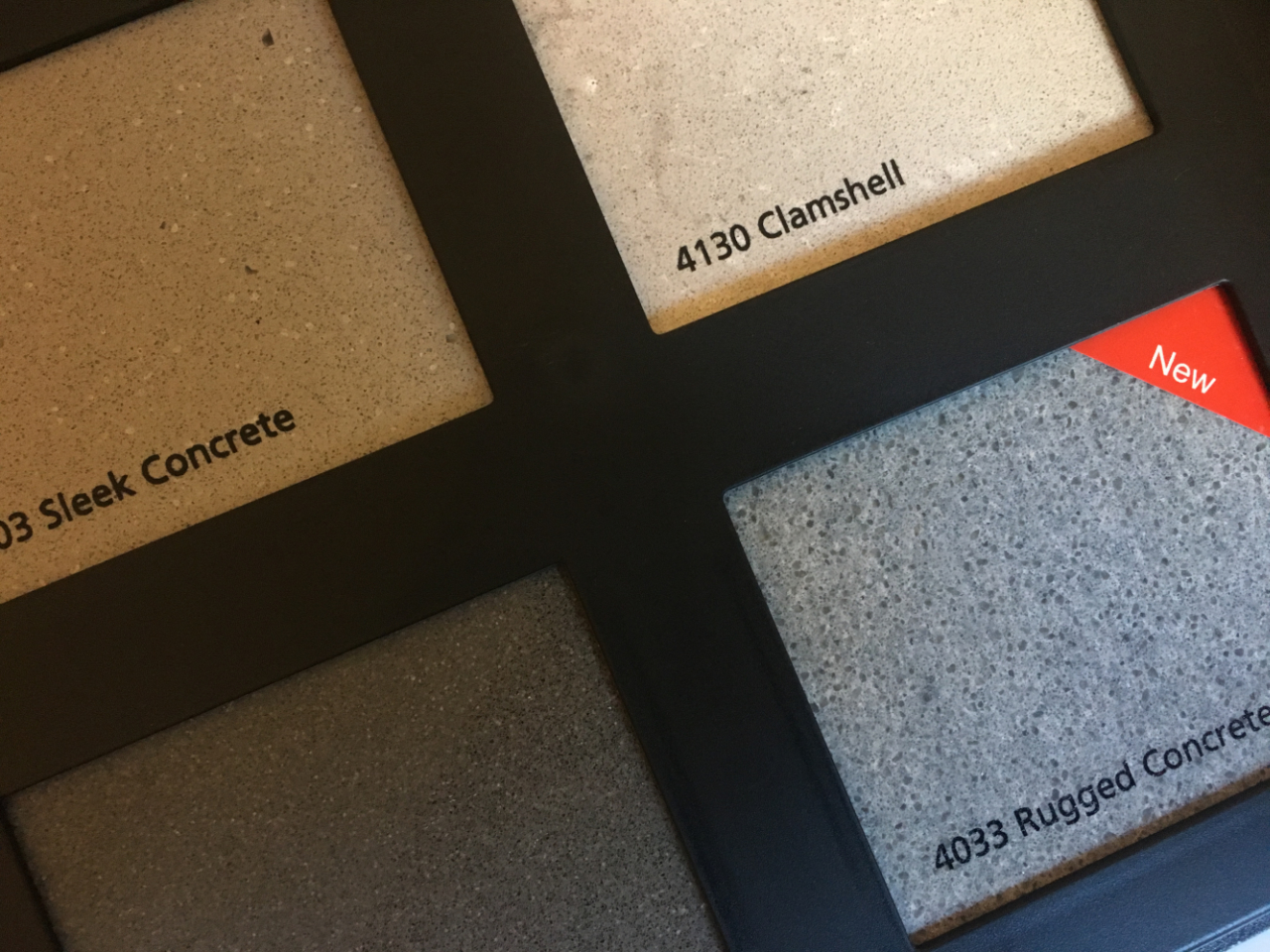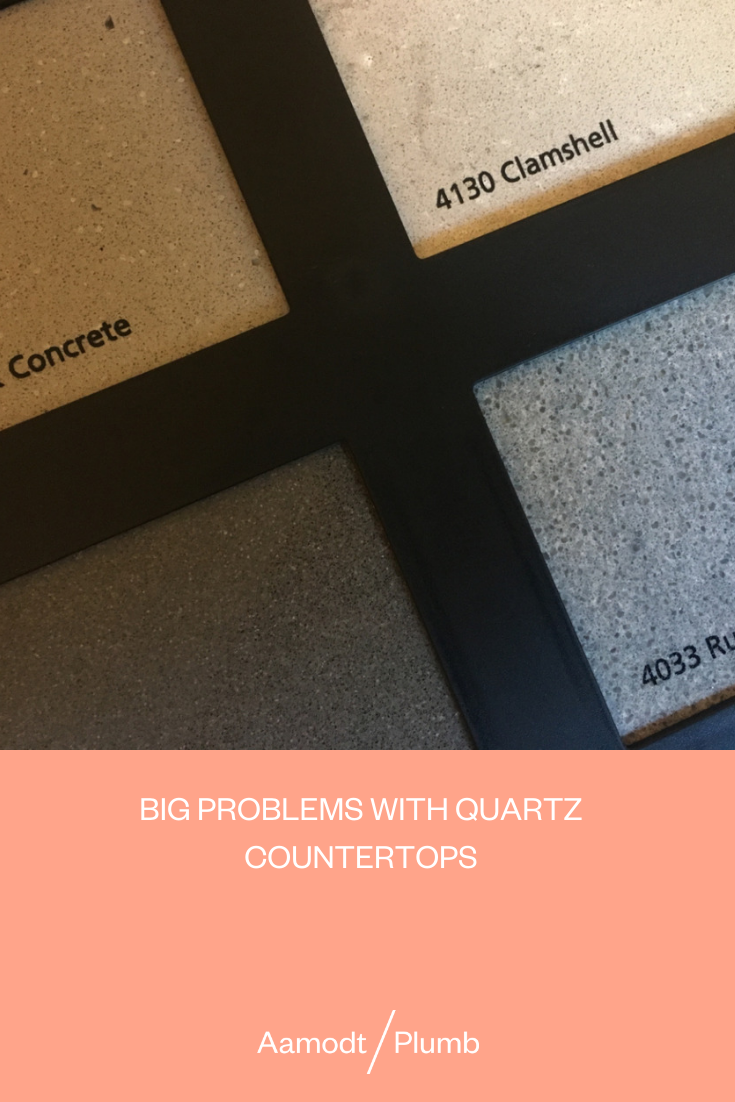
Big Problems With Quartz Countertops
In this episode of Slow Homes, Mette discusses some breaking news about the problems with quartz countertops, a material she mentioned in her video 5 Eco-friendly, Ethical and Beautiful Countertop Materials.
SUBSCRIBE TO THE AAMODT / PLUMB YOUTUBE CHANNEL HERE TO GET MORE VIDEOS ABOUT CREATING A SLOW HOME
PREFER TO LISTEN IN THE CAR OR WHILE ON A WALK? DOWNLOAD OUR PODCAST EPISODE HERE.
Read The Transcript:
Mette Aamodt: Hey folks, welcome to the Aamodt/Plumb YouTube channel. We’re starting a new series on Slow Homes where we give you tips and advice for creating a home that is good, clean and fair. I’m Mette Aamodt, co-founder of Aamodt/Plumb Architecture, Interiors and Construction and I’ll be your host.
Today I have to share some breaking news with you. It’s an update to a previous video that we did on eco-friendly, ethical and beautiful countertops and I need to share some bad news that I just discovered. The day we finished editing that video, David Ascher from our office sent me an article, actually a podcast, from NPR talking about the dangers of engineered stone. And we mentioned engineered stone in our other video as something to avoid and we were primarily focused on the plastic resin binder, which we thought was just yuck in and of itself and turns out it can chip off if you’re cutting on the countertop.
But engineered stone is made up of 10% binder and 90% silica. And silica it turns out is extremely dangerous to work with. So the workers that are fabricating the countertops, that are cutting them, grinding them, polishing them, a new report just came out by the CDC that found 18 cases of silicosis in California, Colorado, Texas and Washington. I’ll explain what silicosis is in a minute.
Silica is a naturally occurring material and it comes in two forms, crystalline and non-crystalline silica. Crystalline silica is found in beach sand, granite, quartz and gravel. Beach sand is not dangerous. Don’t worry about going to the beach. The particles are too big to be inhaled. But fine dust, silica, the kind that’s produced from cutting and grinding stone is extremely harmful. The other type of non-crystalline silica that’s found in glass and silicone is much less harmful.
A new report just came out by the CDC that found 18 cases of silicosis in California, Colorado, Texas and Washington.
So the issue is that when you’re processing stone, you’re cutting, grinding, polishing it, it makes a ton of dust. Dust goes everywhere. Let me read you one quote from one of the sick workers. “If you go into the bathroom, it’s dust. When we go to take lunch on the tables, it’s dust. Your nose, your ears, your hair, all of your body, your clothes, everything. When you walk out of the shop you can see your steps on the floor because of the dust.”
So the problem is that this fine dust full of silica gets embedded deep within the lungs and when it does scar tissue forms around it, hardening the lungs. This is what’s called silicosis. And there’s no remedy for it and eventually it will cause a lot of respiratory issues and in some cases death. And the only way to cure it is a complete lung transplant. Prevention basically comes down to dust control and OSHA does require dust control for any processes that create silica dust.
Our site superintendent, Sean Cowing, he is certified in silica compliance and recommends that everyone who’s working with the material gets this certification as well. The problem is that OSHA doesn’t have the manpower or the mandate to go and check. And apparently there is something like 8,000 stone fabrication shops in the US. Most of them are small and probably most of them aren’t even aware of the dangers of silica. And even if they were managing the dust is a huge undertaking.
So the article references one shop that was very responsible and they were already using a wet cut method. That’s when they spray water on the stone as they’re cutting it to to grab the dust so that it settles down rather than just staying airborne. The dry cutting process puts a lot more dust into the air. So they were already doing that, but they still found that their silica, their airborne silica levels were too high. So then they started cleaning the shop floor every morning, because they noticed there was a fine white dust every morning when they came in. So that was after the nighttime and everything had settled. They started cleaning the floor every day with a kind of Zamboni machine. But even that wasn’t enough. And then finally they installed an all new air handling system and then the levels of silica, airborne silica were imperceptible.

This is what OSHA Silica Compliance Awareness Training certification looks like.
But I don’t know if most small businesses are going to go through the trouble to do all of that. And the ones that do are probably inviting OSHA in to do an inspection of voluntary compliance and that’s great. You can look for companies that have done that, but again, the majority are not going to have either the resources or the wherewithal to do that.
Now, the US is not the only place having this problem. There are also problems noted and clusters of silicosis in Australia, Israel, Spain, and Italy. But imports of engineered stone have increased from 2010 to 2018 by 800%. So I’m sure we’re going to be seeing a lot more of this in the news.
Please share this video widely so other people can be aware of the dangers of engineered stone. It’s not dangerous to the homeowner themselves, but it’s very dangerous to the workers and as part of our commitment to creating homes that are good, clean, and fair, we highly recommend not choosing engineered stone for your kitchen countertops.
Now, don’t worry if you already have engineered stone in your house. We didn’t know this either. Okay. This is breaking news and it just came out, CDC report ,the NPR article. So we didn’t know. We thought it was the plastic that was the problem, but it’s the silica. And now that we know we need to let other people know. So please share this video and please also subscribe to our channel to get other tips and advice as well as other breaking news to help you create a home, a slow home that is good, clean and fair. Thanks.
SUBSCRIBE TO THE AAMODT / PLUMB YOUTUBE CHANNEL HERE TO GET MORE VIDEOS ABOUT CREATING A SLOW HOME
Here are the links mentioned:
Workers Are Falling Ill, Even Dying, After Making Kitchen Countertops: https://www.npr.org/sections/health-shots/2019/10/02/766028237/workers-are-falling-ill-even-dying-after-making-kitchen-countertops
Severe Silicosis in Engineered Stone Fabrication Workers — California, Colorado, Texas, and Washington, 2017–2019: https://www.cdc.gov/mmwr/volumes/68/wr/mm6838a1.htm





